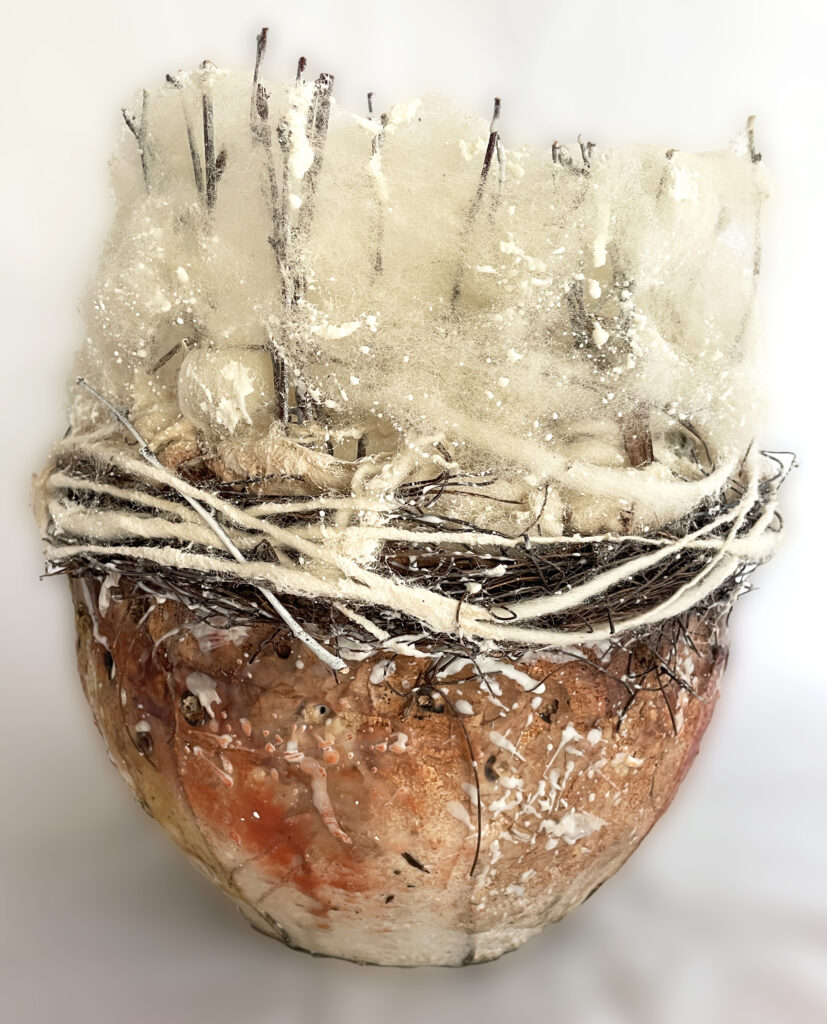
Lyn Belisle. 2025
(From the Dictionary: Woolgathering once literally referred to the act of gathering loose tufts of wool that had gotten caught on bushes and fences as sheep passed by. As you might imagine, woolgathering was not the most profitable of enterprises; its practitioners must have seemed to wander aimlessly, gaining little for their efforts. In the mid-16th century, woolgathering began to appear in figurative phrases such as “my wits went a woolgathering”—in other words, “my mind went wandering.” From there, it wasn’t long before the word woolgathering came to suggest daydreaming and mind-wandering.)
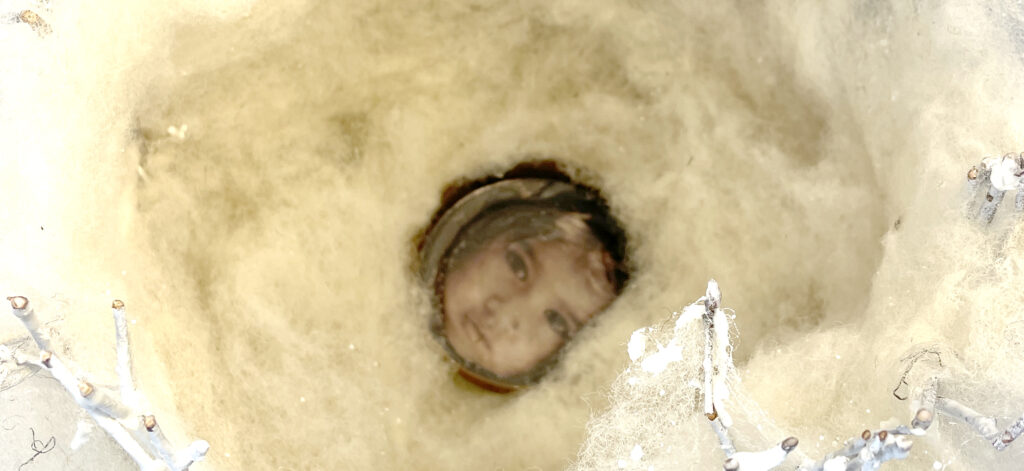
There is no Oracle Card for this post, but I do want to talk about something else that artists and makers hear a lot – that “Trust the Process” advice. In Shaun McNiff’s book by that name, he defines “trusting the process” as an embodied practice of letting go, staying open, embracing imperfection, engaging in improvisation, and responding to the evolving work—not insisting on a fixed result. It’s trusting that the creative intelligence inherent in the process itself will carry you to unexpected and resonant places.
What does that actually mean? Here’s a real example from my own studio that happened when I wanted to create a piece for the Fiber Artists of San Antonio juried exhibition, Rooted in Fiber: The Natural Textures of Texas.
I started this piece with only a loose idea in mind—I wanted to make a vessel that would somehow reflect the call for entry, which asked artists to highlight our ties to the Texas landscape and textile traditions.
So I made a plain white form out of plaster and fiber. It sat on my table like a question mark: now what?
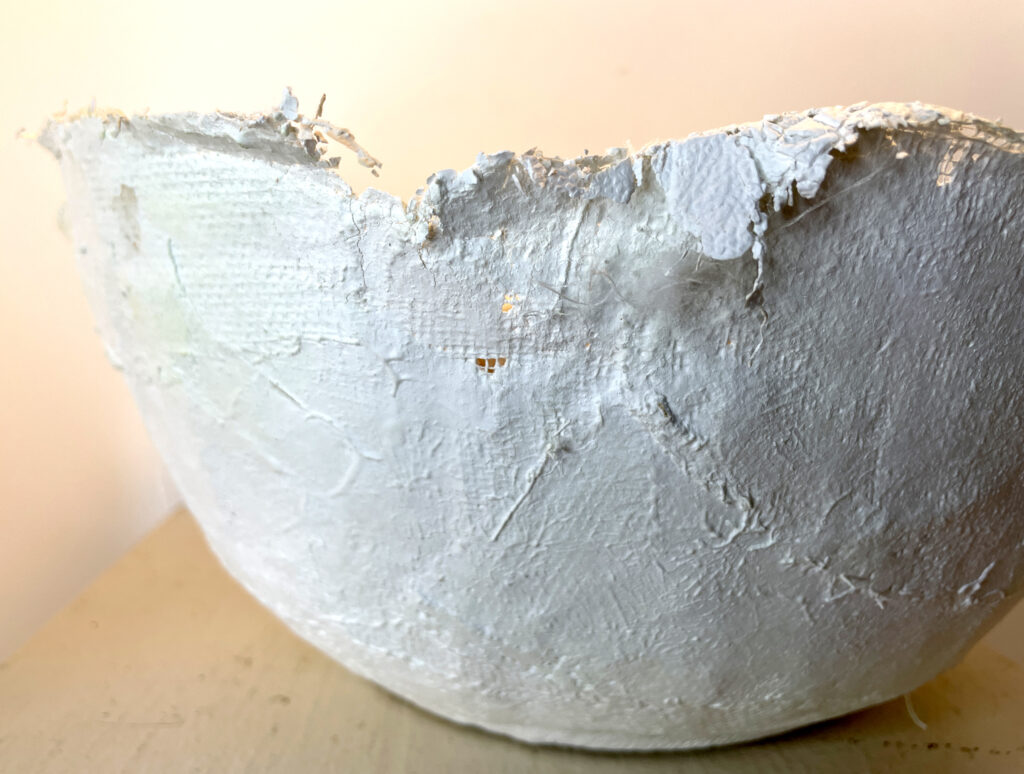
That’s when the process started asking me to trust it. My first risky move was burning holes into the surface with a soldering iron. It always feels scary—what if I ruin it? But the holes gave the vessel air, a kind of breath. (I thought about threading yarn through them, but that felt too simple, too obvious.)
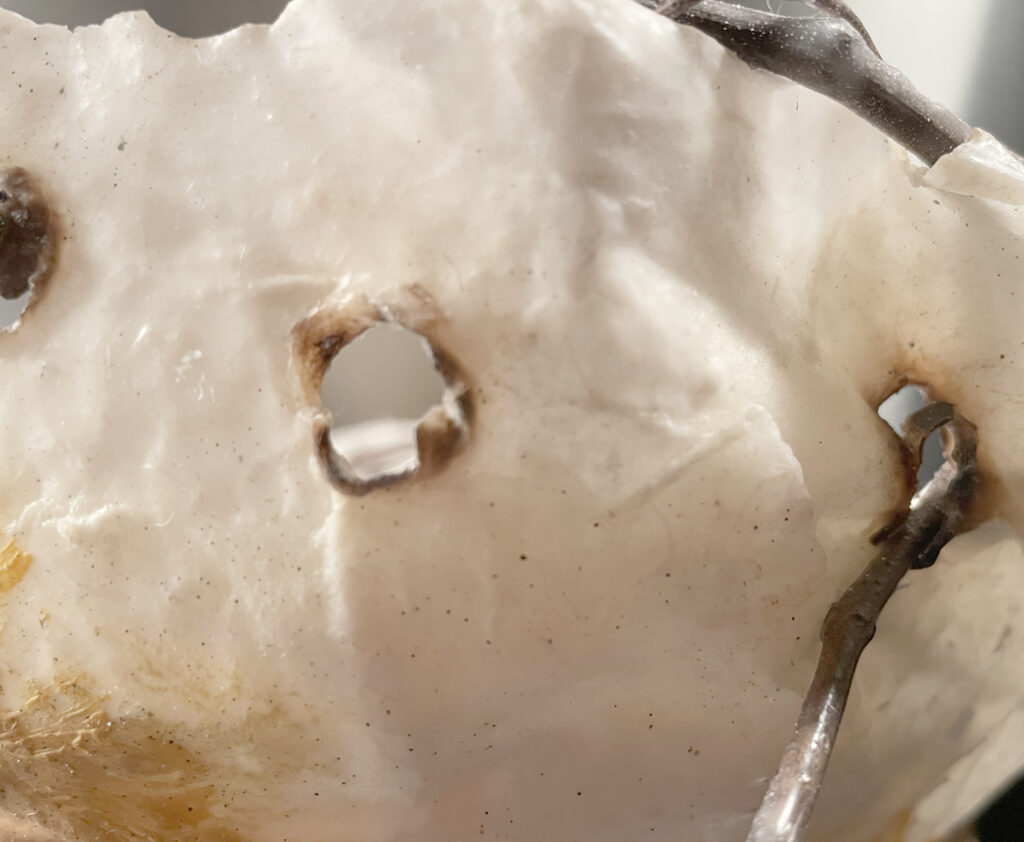
Next came long sticks and a branched rim. That looked promising, but the proportions were off—it seemed more like a bowl trying to become a bonfire. I painted everything white to unify it. Still, it wasn’t quite there. (Note – it really IS pretty, but I was trying to honor the theme of the exhibition by creating a conversation about Texas fiber and this was going in the wrong direction – I’m saving this idea, though!!).
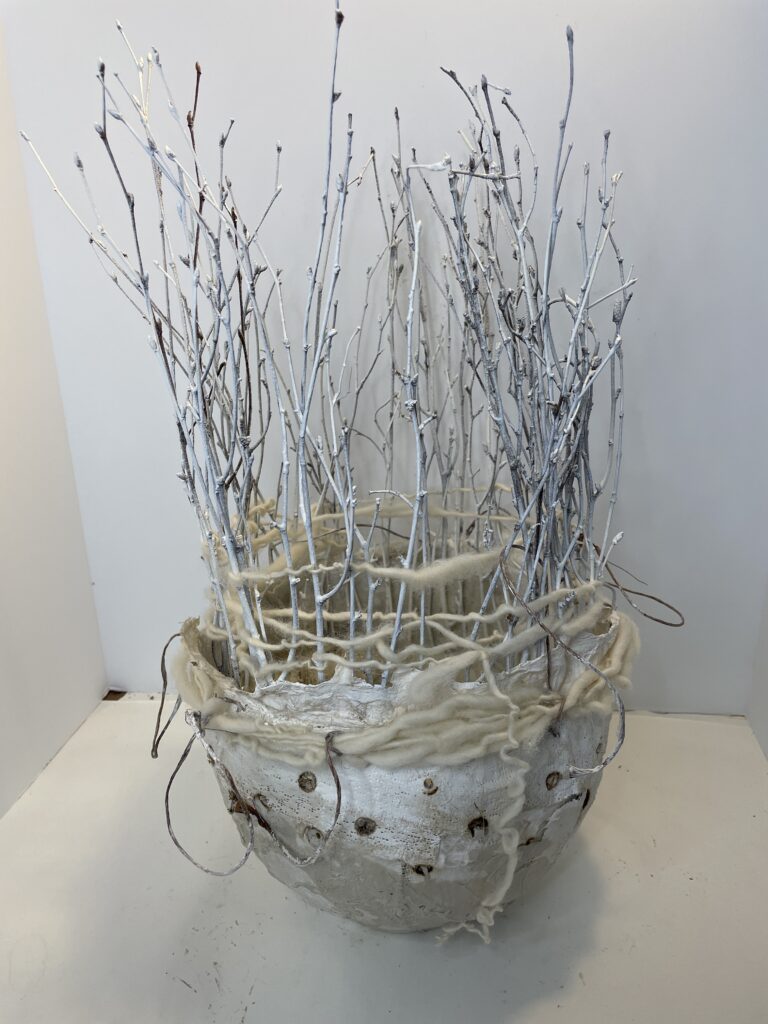
Then I stained the rim with walnut ink, hoping the earth tone would anchor the piece.
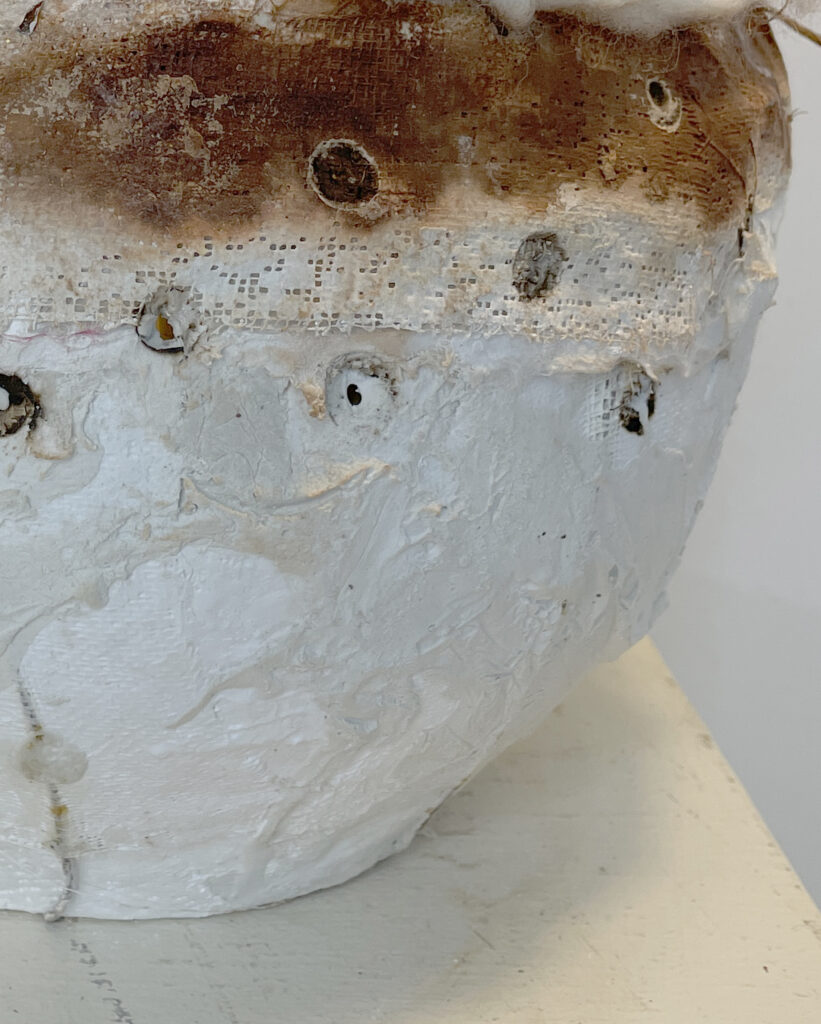
The shift came when I added unspun wool roving to the rim. Suddenly, something clicked.
On impulse, I looked up the word woolgathering. I discovered it referred not only to pulling scraps of wool from fences after sheep passed by—a task rooted in Texas’s textile history—but also to the act of daydreaming. That was the key.
But I had to cut back the sticks to change the focus and to reflect the idea of a rustic fence.
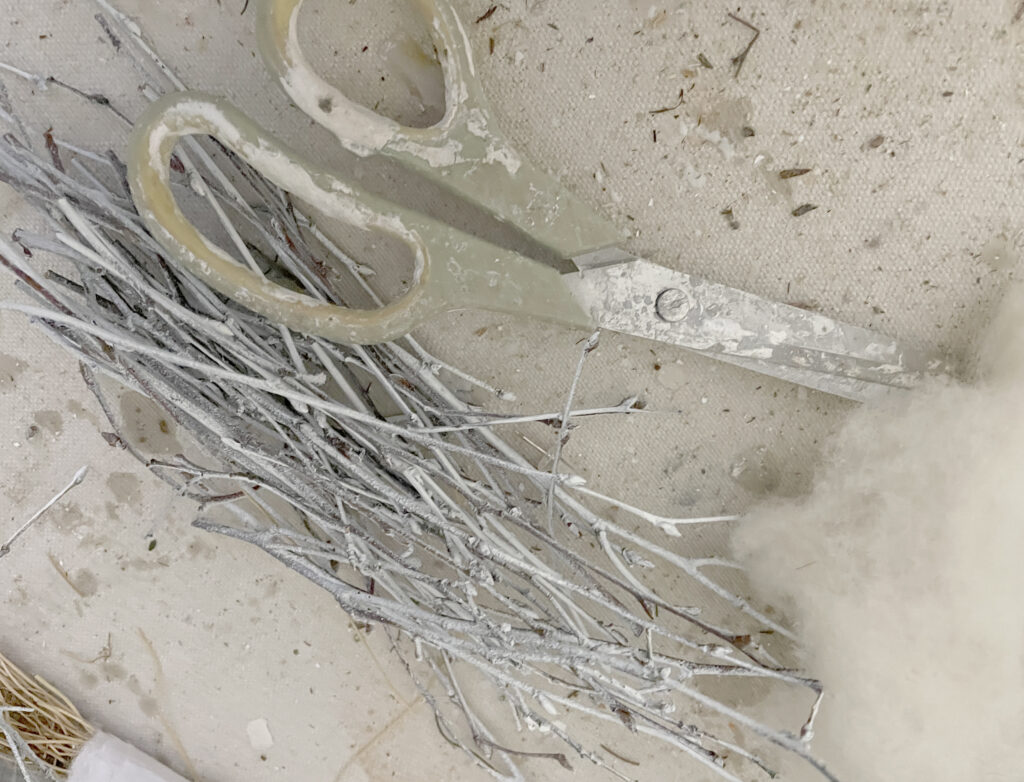
Cutting the sticks down was painful—they were beautiful, but they were overwhelming the form. Once shortened, though, they offered a perfect fench-like perch for bits of wool.
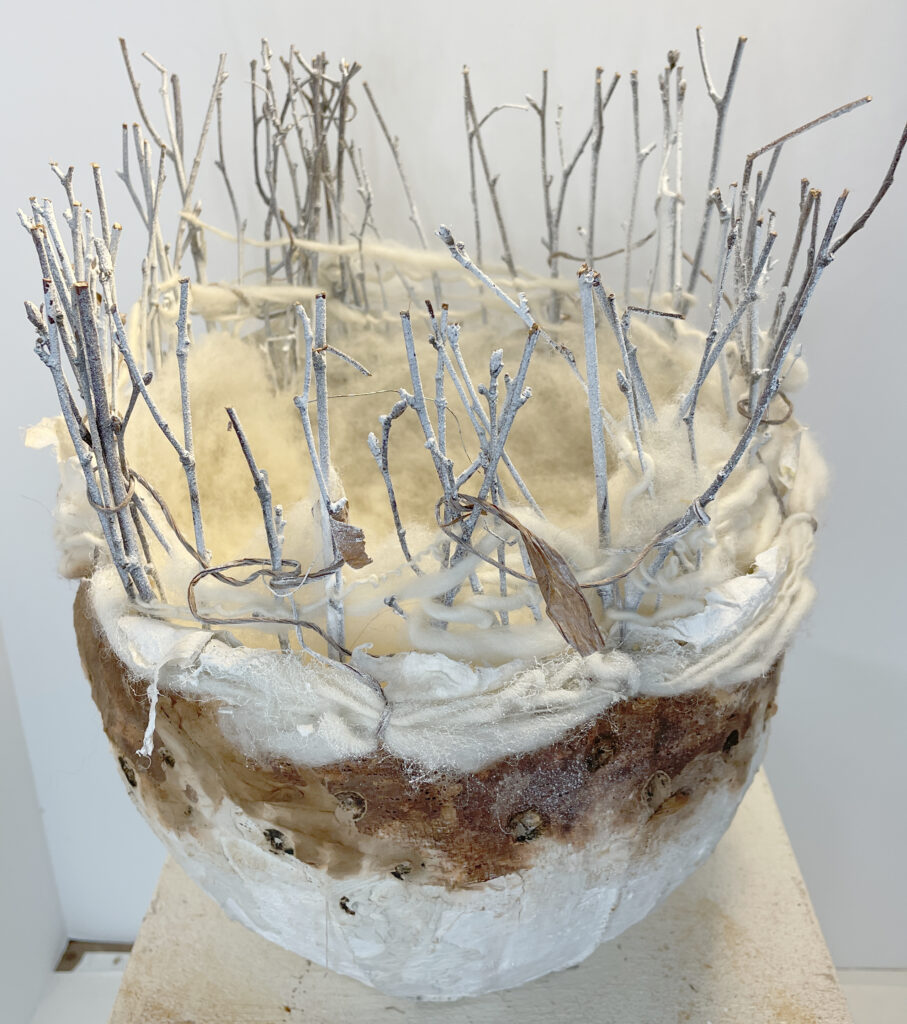
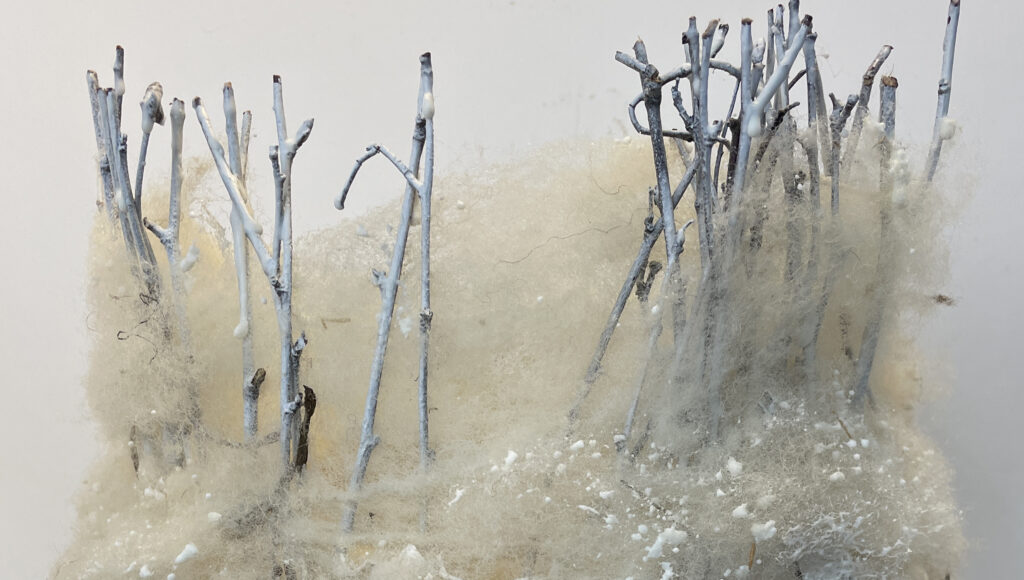
After reshaping the twigs, I brushed encaustic wax across the vessel’s surface and rubbed in pan pastels, earthy tones that recalled the grazing fields of sheep.
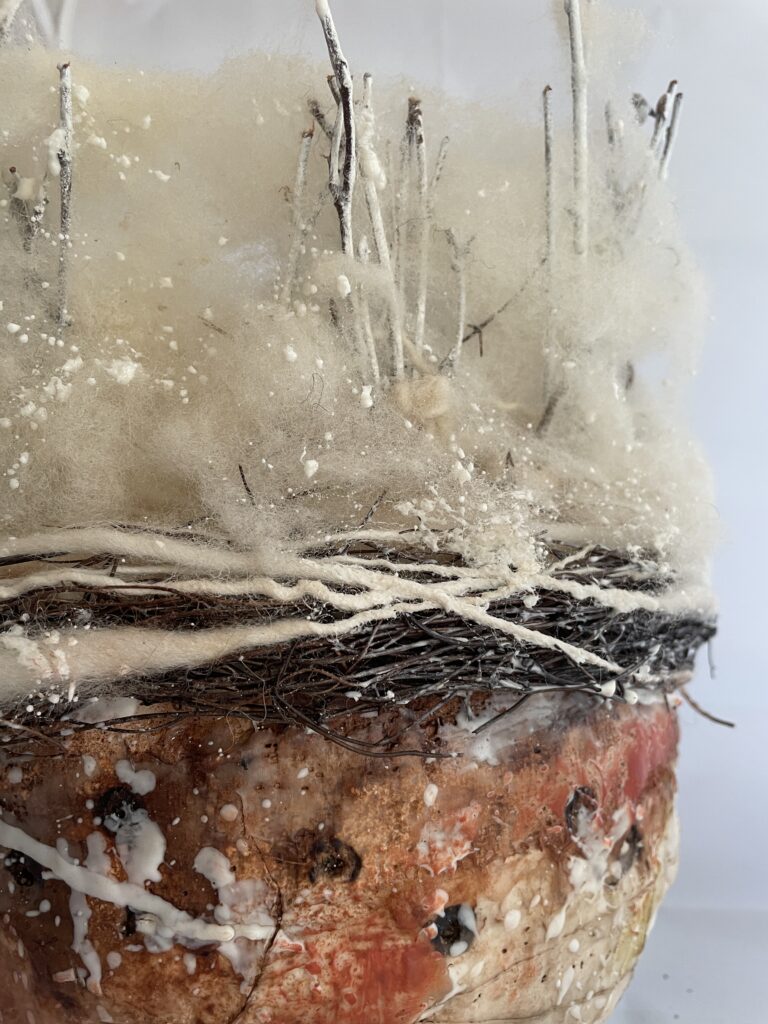
The vessel seemed to root itself in the land. When the wool was woven and integrated into the rim, I added final “sparkles” of white wax across the surface, echoing both stray tufts of wool caught on fences and the small white wildflowers that brighten Texas pastures. At last, the vessel became whole.
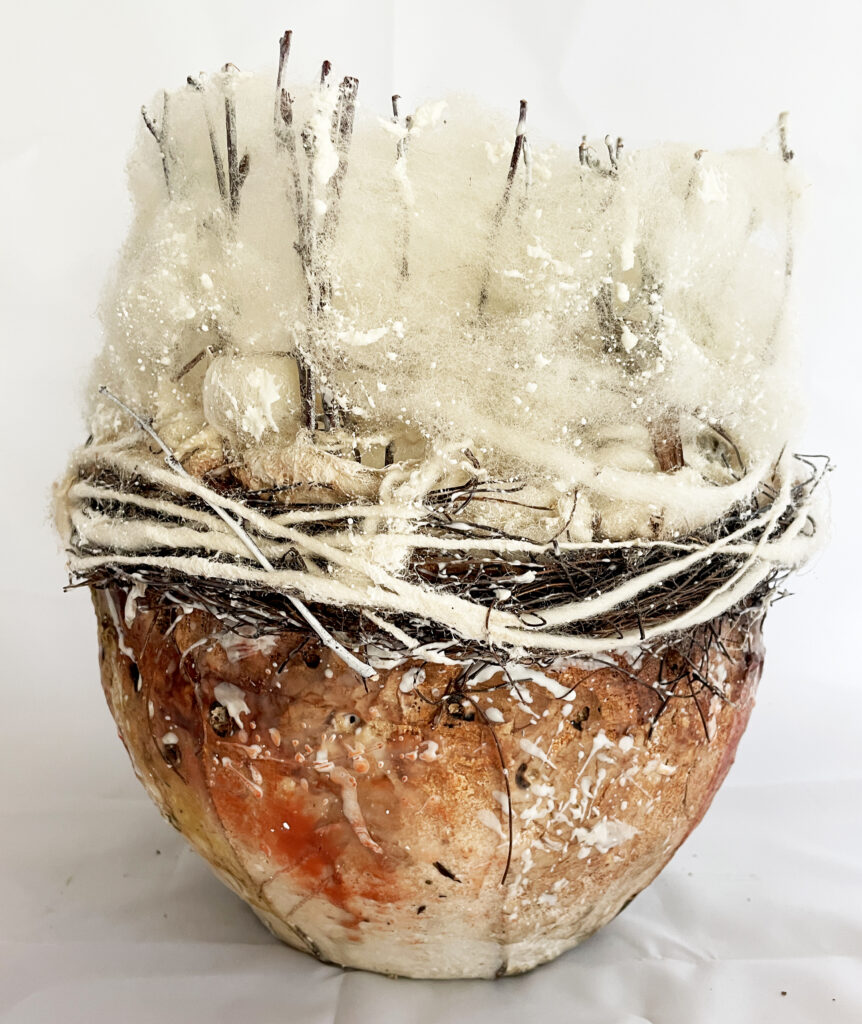
Every stage of this work asked me to let go, to take a chance, to risk losing what I had in order to find something better.
Woolgathering is the result: a vessel that holds both memory and imagination.
It carries the story of Texas’s fiber traditions, of sheep and goats shaping the land, and also the quiet act of wandering thought. For me, it’s a reminder that trusting the process is less about control and more about listening—about gathering scraps, following clues, and allowing the work to become what it wants to be.
And maybe that’s true for all of us, no matter what we’re making: the real beauty often emerges in the space between what we plan and what we dare to discover.
For me, trusting the process shows up in a lot of different ways:
-
Following a hunch. Sometimes I don’t know why I reach for a certain tool or material—I just feel the pull. Trusting the process means letting myself act on those impulses without needing a guarantee that they’ll work.
-
Welcoming accidents and discoveries. When I looked up the meaning of woolgathering, it was almost by accident, but that small act gave me the concept that tied everything together. Trusting the process means staying open to those chance encounters and letting them shift the work in a new direction.
-
Pausing when needed. There were moments when the vessel just wasn’t working, and I had to stop and wait for the next clue to reveal itself. Trusting the process means giving myself patience and permission not to solve everything at once.
-
Being willing to risk and revise. Cutting down those tall, beautiful sticks was hard, but it changed everything for the better. Trusting the process means being brave enough to undo or alter something I love for the sake of the whole piece.
-
Listening more than controlling. Over time, the vessel began to tell me what it wanted to become. Trusting the process means letting the work guide me, rather than forcing it to fit a plan I made at the start.
So for me, trusting the process isn’t just one thing—it’s following hunches, welcoming surprises, taking breaks, risking change, and listening carefully. It’s my way of saying: “I don’t know exactly where this is going yet, but I trust it will show me.”
My Invitation to You
How does trusting the process show up in your own work? I’d love to hear where uncertainty has led to discovery in your creative practice.

This just sums up what I’ve been doing for 25 years. When I begin an animal with clay, I really have no idea what it will be. The clay tells me. Then when it’s all finished, many people ask me what it is. I don’t answer because I want them to tell me. Everyone has a different answer. It brings me great joy.
Yes!! You expressed it perfectly! Thanks, Leslie!
Your work is beautiful & I always learn so much from you. This is a great description of process, inspiring & encouraging.
Thanks, Connie – xoxo
Your work is beautiful & I always learn so much from you. This is a great description of process, inspiring & encouraging.
Lyn,
As I unpacked my vessels and everything from my suitcase, I found the wool I had picked up from my walk to the beach around the salt marshes in Mulranney. As stated the sheep brush up against shrubs and fences and leave it behind while out grazing for people like me who value it. I knew in that instance it needed to live inside Up My Street and now it’s home again like me:)
I’ll send you a pic
I love that photo!! Thank you!!
So wonderfully beautiful and inspiring. Can’t wait too start my vessel course. I have some silk spun fibers to tease apart and solidify. Some gorgeous colours.
Thank you, Linda – 🙂
The vessel is compelling and the story behind it inspirational. Thanks for all the Shards positing. I look forward to reading them each time they arrive in my inbox. xoxo
You are such an inspiration – I love our conversations about art and printmaking and what works and what doesn’t. ♥
Lyn, What a fabulous culmination to simple findings! I love it!
Lucy, you are the best – you know the magic of putting things together!
Beautiful piece Lyn, and lovely to see your process!
Aww, Susie – thank you so much – I have learned so much about the Language of Art from you. ♥
This is very close to home for me in my acrylic collage landscapes. Each layer is a teachable moment of patience and placement of the next layer is dictated by what needs to be revealed to evoke interest in the landscape and what needs to be concealed to edit pattern and quiet a piece down. I feel like I get better at this through each piece I accomplish and I no longer worry that I’ve ruined a piece by my actions.
What a brilliant summary!! Your acrylic collage landscapes are such complete stories in themselves – layered and complex and yet easy to engage with – 🙂
My husband, Morris, used to preach “it’s all about the process” whenever I began a project. “Go slow and enjoy every step and working through the challenges.” In 1997 he started building a 47′ X 15′ sailboat in our backyard. (He had to cut down some small trees.) Then came the time to have the boat lifted over our house and anchored to a trailer that moves boats over land. (The feat was televised and shown on the local news and some national stations.) The boat was trailered to the gulf coast in Alabama where the mast and life lines would be installed.
Morris died before the boat ever got in the water, but his joy came from time spent building the boat and solving problems along the way – the process.
This is an incredible story, Marilyn – it’s a bright metaphor and a wise parable for all of us – thank you for sharing it.
Lyn,
Incredible cards. You’ve captured the essence so beautifully. It’s like you’ve entered the realm of universal creativity and delicately commanded the words through invitation to gather together to reflect and mirror the process that occurs when one allows themselves into that symbiosis that humans are capable of. Beautifully written.
As I reviewed the cards, I was once again transported back into the experiences. Well done…. Elizabeth
Sending much love to you and all you give back through your own beautiful work, Elizabeth!
Awesome work!!! I go paint once a week with my artist friends. If the weather is decent we paint plein aire. Whle we paint there is always a time when we say. Ugh!!! We call this the ugly stage. When we have to decide if we want to continue, go back to that one later and start again or change parts of it. I love watching your documented progress because you add and change.
Yes! The ugly stage – it’s also the scary stage – but if you just keep one foot in front of the other and take the next step, it’s usually the right one. ♥
Lyn, Everything about this is beautiful, your words, your images, your process and the finished product. Inspirational! Thank you. Pam
Pam, you made my day – you know how much I love your work 🙂
Magnificent! So full of Joy!!…
Penney! Thank you so much – sending a hug!
Dr. Jake Scott is on the front line of his second pandemic in five years and he is not getting much sleep.
Scott works full-time as an infectious disease physician at Stanford Health Care’s Tri-Valley hospital in Pleasanton, California. When he is done taking care of his patients and his two grade-school aged kids, he often stays up past midnight writing — furiously penning op-eds, collecting studies, leading evidence reviews and posting meaty threads on social media, most of them correcting the record on vaccines.
[url=https://tripscan43.biz]трипскан вход[/url]
Often, he’s reacting to the latest maneuvers by US Health and Human Services Secretary Robert F. Kennedy Jr.. A pinned post responding to one of Kennedy’s appearances on Fox News has been viewed almost 5 million times. Another post fact-checking Kennedy’s claims about potential harms from aluminum in vaccines had 1 million views in its first 48 hours. Scott’s followers on X have doubled since April.
https://tripscan43.biz
tripscan войти
“A million views for this long-winded, very detailed, kind of nerdy breakdown of the science,” Scott said, marveling at the attention it got. “I think that’s saying something, you know? People want that information, and they deserve it,” said Scott who is 48.
The Covid-19 pandemic turned many infectious disease specialists and virologists into household names. Scott’s was not one of them, perhaps because he was too busy treating patients. He didn’t stay out of the public discourse completely, however. He was one of the first doctors to tell people that Omicron didn’t seem to be as severe an infection as earlier strains of the virus, although some virologists were skeptical at the time.
In President Donald Trump’s second administration, however, Scott is taking on what he sees as a second pandemic — misinformation and disinformation about vaccines. He knows false information can be as harmful as any virus.
“When officials spread inaccurate information about vaccines, it does have real consequences, and families make decisions based on fear rather than on facts,” Scott said.
It’s already happening. The US Centers for Disease Control and Prevention recently reported data showing kindergarten vaccination rates continue to decline, as states make it easier to opt out of school vaccination requirements. Vaccine preventable diseases like measles and whooping cough are rising again, too.
Scott knows it could get much worse.
“In 2021, nearly every single patient I lost to Covid was unvaccinated by choice, and every colleague of mine has said the same thing.”
Pingback: Juried Shows and Oracle Cards | SHARDS: fragments and reflections